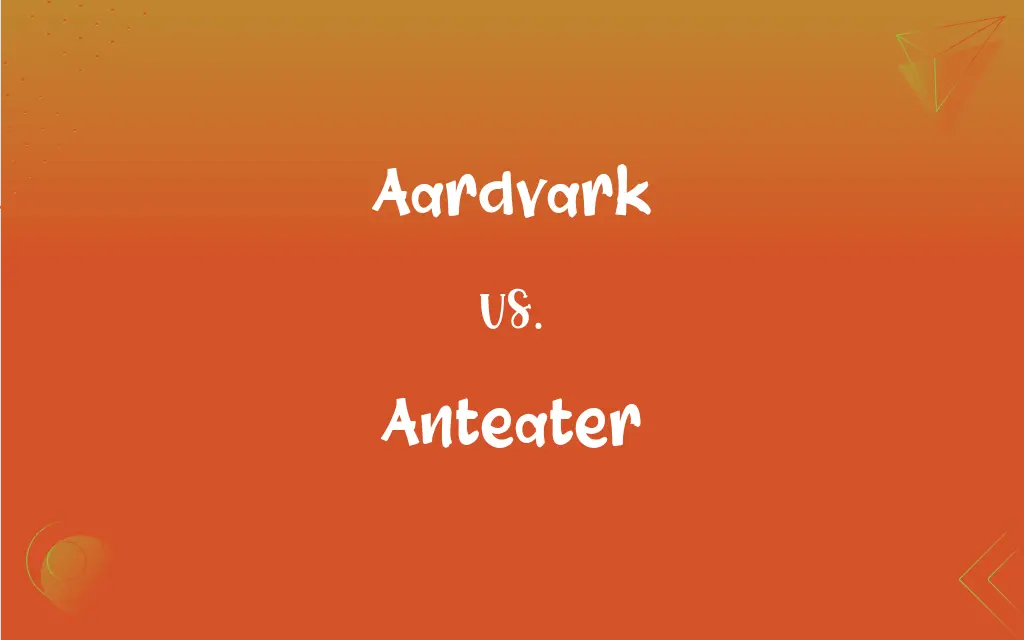Aardvark vs. Anteater: What's the Difference?
Edited by Janet White || By Harlon Moss || Updated on October 15, 2023
Aardvark is a nocturnal mammal native to Africa, while an anteater is native to Central and South America and feeds primarily on ants and termites.

Key Differences
Aardvarks are unique mammals indigenous to Africa. Recognized for their pig-like snout and powerful digging claws, they are solitary creatures that come out at night. Anteaters, contrastingly, belong to a group of four species native to Central and South America. While both consume ants and termites, their anatomical structures and origins differentiate them significantly.
Aardvarks boast tubular ears and a long, sticky tongue that can reach up to 12 inches, aiding them in capturing their prey from within tunnels. Anteaters possess an elongated snout and a tongue that can extend up to 2 feet. Their lengthy tongue swiftly flicks in and out, allowing them to consume thousands of ants daily.
Despite their somewhat similar diets, aardvarks and anteaters belong to different taxonomic families. The aardvark is the only member of the Orycteropodidae family, making it truly distinct. Anteaters, on the other hand, are part of the Myrmecophagidae family, showcasing diverse species ranging from the giant anteater to the silky anteater.
A notable aspect of the aardvark's behavior is its ability to dig rapidly, often creating new burrows each night. Anteaters, in contrast, do not typically dig but utilize their powerful, curved claws primarily for defense and tearing open ant and termite mounds.
Although both the aardvark and anteater have evolved to feed on ants and termites, their geographical habitats, physical characteristics, and behaviors set them apart. They are unique mammals, each contributing to the biodiversity of their respective continents.
ADVERTISEMENT
Comparison Chart
Origin
Africa
Central and South America
Diet
Ants, termites, and other insects
Primarily ants and termites
Physical Attributes
Pig-like snout, tubular ears
Elongated snout, long tongue
Taxonomic Family
Orycteropodidae
Myrmecophagidae
Behavioral Traits
Nocturnal, solitary, digs burrows
Mostly diurnal, solitary, uses claws for defense
ADVERTISEMENT
Aardvark and Anteater Definitions
Aardvark
A nocturnal, burrowing mammal native to Africa.
The aardvark dug a new burrow to escape the midday heat.
Anteater
A mammal native to Central and South America, specialized in consuming ants and termites.
The anteater used its long tongue to gather ants from the mound.
Aardvark
An animal recognized for its pig-like appearance and strong digging capabilities.
The aardvark's powerful claws allow it to dig rapidly when threatened.
Anteater
A member of the Myrmecophagidae family, ranging from the giant to the silky anteater.
The giant anteater is the largest species within the anteater family.
Aardvark
A solitary creature found predominantly in sub-Saharan Africa.
During our safari, we were fortunate to spot a rare aardvark.
Anteater
An animal with a slender, elongated snout and a tongue that can extend up to 2 feet.
The anteater's unique snout is perfectly designed for reaching into narrow spaces.
Aardvark
The only member of the Orycteropodidae family.
The unique characteristics of the aardvark set it apart from other mammals.
Anteater
A creature equipped with sharp, curved claws primarily for defense.
When threatened, the anteater stands on its hind legs, ready to use its claws.
Aardvark
An insectivorous animal with a long snout and sticky tongue.
The aardvark's diet consists mainly of ants and termites.
Anteater
An animal that can consume thousands of ants daily.
Anteaters play a crucial role in controlling ant populations in their habitats.
Aardvark
A burrowing mammal (Orycteropus afer) of sub-Saharan Africa, having a stocky body, large ears, a long tubular snout, and powerful digging claws for feeding on ants and termites.
Anteater
Any of several Central and South American mammals of the suborder Vermilingua that lack teeth and feed on ants and termites, especially the giant anteater.
Aardvark
The nocturnal, insectivorous, burrowing, mammal Orycteropus afer, of the order Tubulidentata, somewhat resembling a pig, common in some parts of sub-Saharan Africa.
The aardvark burrows in the ground and feeds mostly on termites, which it catches with its long, slimy tongue.
Anteater
Any of several other animals, including the echidna, aardvark, and pangolin, that feed on ants.
Aardvark
An edentate mammal, of the genus Orycteropus (Orycteropus afer), somewhat resembling a pig, common in some parts of Southern Africa. It is a nocturnal ungulate, burrows in the ground with its powerful claws, and feeds entirely on ants and termites, which it catches with its long, extensile, slimy tongue. It is the sole extant representative of the order Tubulidentata.
Aardvark
Nocturnal burrowing mammal of the grasslands of Africa that feeds on termites; sole extant representative of the order Tubulidentata
FAQs
Where is the aardvark found?
The aardvark is native to Africa.
What is the primary diet of an aardvark?
Aardvarks mainly eat ants, termites, and other insects.
Do aardvarks and anteaters belong to the same family?
No, aardvarks are in the Orycteropodidae family, while anteaters belong to the Myrmecophagidae family.
Do anteaters live in groups?
No, anteaters are also solitary animals.
How long is the aardvark's tongue?
An aardvark's tongue can reach up to 12 inches.
Are anteaters found in Africa?
No, anteaters are native to Central and South America.
Are aardvarks solitary animals?
Yes, aardvarks are typically solitary creatures.
How many species of anteater are there?
There are four main species of anteater.
Can anteaters climb trees?
Yes, some species of anteater, like the tamandua, are adept climbers.
What predators do aardvarks face?
Lions, leopards, and hyenas are among the predators of aardvarks.
How long is the gestation period for anteaters?
Depending on the species, the gestation period for anteaters can range from 120 to 190 days.
Are aardvarks and anteaters closely related?
No, despite some similarities in diet and appearance, aardvarks and anteaters are not closely related.
How does an anteater consume its food?
Anteaters use their long, sticky tongue to capture ants and termites.
How do aardvarks protect themselves?
Aardvarks dig burrows rapidly to escape predators.
What time of day are aardvarks most active?
Aardvarks are primarily nocturnal.
Are aardvarks related to pigs?
No, despite their pig-like appearance, aardvarks are not related to pigs.
What do young anteaters eat?
Young anteaters consume milk from their mothers before transitioning to ants and termites.
How do aardvarks communicate?
Aardvarks use a variety of vocalizations, including grunts and bleats.
What is the primary defense mechanism of anteaters?
Anteaters use their sharp, curved claws primarily for defense.
Are anteaters nocturnal?
Some species, like the giant anteater, are diurnal, while others can be nocturnal.
About Author
Written by
Harlon MossHarlon is a seasoned quality moderator and accomplished content writer for Difference Wiki. An alumnus of the prestigious University of California, he earned his degree in Computer Science. Leveraging his academic background, Harlon brings a meticulous and informed perspective to his work, ensuring content accuracy and excellence.
Edited by
Janet WhiteJanet White has been an esteemed writer and blogger for Difference Wiki. Holding a Master's degree in Science and Medical Journalism from the prestigious Boston University, she has consistently demonstrated her expertise and passion for her field. When she's not immersed in her work, Janet relishes her time exercising, delving into a good book, and cherishing moments with friends and family.































































